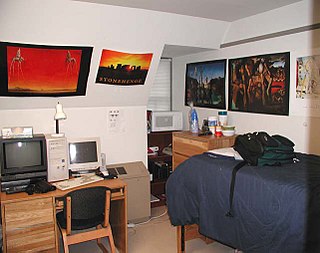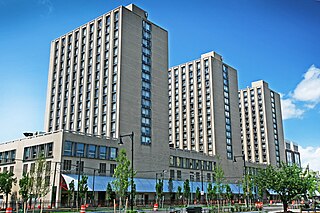
The University of California, Santa Cruz is a public land-grant research university in Santa Cruz, California. It is one of the ten campuses in the University of California system. Located on Monterey Bay, on the edge of the coastal community of Santa Cruz, the campus lies on 2,001 acres (810 ha) of rolling, forested hills overlooking the Pacific Ocean. In Fall 2022, its ten residential colleges enroll some 17,500 undergraduate and 2,000 graduate students.

A dormitory is a building primarily providing sleeping and residential quarters for large numbers of people such as boarding school, high school, college or university students. In some countries, it can also refer to a room containing several beds accommodating people.

Kresge College is one of the residential colleges that make up the University of California, Santa Cruz. Founded in 1971 and named after Sebastian Kresge, Kresge college is located on the western edge of the UCSC campus. Kresge is the sixth of ten colleges at UCSC, and originally one of the most experimental. The first provost of Kresge, Bob Edgar, had been strongly influenced by his experience in T-groups run by NTL Institute. He asked a T-group facilitator, psychologist Michael Kahn, to help him start the college. When they arrived at UCSC, they taught a course, Creating Kresge College, in which they and the students in it designed the college. Kresge was a participatory democracy, and students had extraordinary power in the early years. The college was run by two committees: Community Affairs and Academic Affairs. Any faculty member, student or staff member who wanted to be on these committees could be on them. Students' votes counted as much as the faculty or staff. These committees determined the budgets and hiring. They were also run by consensus. Distinguished early faculty members included Gregory Bateson, former husband of Margaret Mead and author of Steps to an Ecology of Mind; Phil Slater, author of The Pursuit of Loneliness; John Grinder, co-founder of Neuro-linguistic programming and co-author of The Structure of Magic; and William Everson, one of the Beat poets.

Benjamin F. Porter College, known colloquially as Porter College, is a residential college at the University of California, Santa Cruz. It is located on the lower west side of the university, south of Kresge College and north of Rachel Carson College. The college was founded in 1969 as College Five and formally dedicated on November 21, 1981. On that day the college was given the motto Ars Longa, Vita Brevis, and a series of college symbols, including a faculty mace and a college bell, were inaugurated.

Adlai E. Stevenson College, known colloquially as Stevenson College, is a residential college at the University of California, Santa Cruz. Currently, the college is host to the Linguistics Department, as well as many humanities faculty.

Merrill College is a residential college at the University of California, Santa Cruz. The theme of the college, and the name of its freshman core course, is "cultural identities and global consciousness."

Missouri Southern State University is a public university in Joplin, Missouri. It was established in 1937 as Joplin Junior College. The university enrolled 4,346 students in Fall 2021.

The Boston University housing system is the 2nd-largest of any private university in the United States, with 76% of the undergraduate population living on campus. On-campus housing at BU is an unusually diverse melange, ranging from individual 19th-century brownstone town houses and apartment buildings acquired by the school to large-scale high-rises built in the 60s and 2000s.

West Campus is a residential section of Cornell University's Ithaca, New York campus located west of Libe Slope and between the Fall Creek gorge and the Cascadilla gorge. It now primarily houses transfer students, second year students, and upperclassmen.

North Campus is a residential section of Cornell University's Ithaca, New York, campus located north of Fall Creek. It primarily houses freshmen. North Campus offers programs which ease the transition into college life for incoming freshmen. The campus offers interactions with faculty and other programs designed to increase interaction among members of the freshman class. North Campus is part of Cornell's residential initiative.
Washington University in St. Louis has varied programs and events for students.
Page Smith was an American historian, professor and author. In 1964 he became the founding Provost of Cowell College, University of California, Santa Cruz and resigned from the university in 1973 in protest. As an activist, he was a lifelong advocate for homeless people, for community organization, and for improving the prison system.

Schenley Quadrangle is a cluster of University of Pittsburgh ("Pitt") residence halls that is a Pittsburgh History and Landmarks Foundation Historic Landmark and are contributing properties to the Schenley Farms National Historic District in Pittsburgh, Pennsylvania, United States.

There are currently 33 undergraduate residence halls at the University of Notre Dame, including 32 active residence halls and Zahm Hall, which serves as a transition dorm when residence halls undergo construction. Several of the halls are historic buildings which are listed on the National Register of Historic Places. Each residence hall is single-sex, with 17 all-male residence halls and 15 all-female residence halls. Notre Dame residence halls feature a mixed residential college and house system, where residence halls are the center of the student life and some academic teaching; most students stay at the same hall for most of their undergraduate studies. Each hall has its own traditions, events, mascot, sports teams, shield, motto, and dorm pride. The university also hosts Old College, an undergraduate residence for students preparing for the priesthood.
The McCormick Road Dormitories are one of two main areas of first-year living dormitories at the University of Virginia, the other being the Alderman Road Dormitories. Ten houses make up the residence area located on McCormick Road. The dormitory area was constructed in 1950 and holds nearly 1300 students. Although older and lacking in modern amenities compared to "New Dorms," Old Dorms are closer to Central Grounds and contain larger rooms.
Since the founding, Stanford University has provided on-campus housing for students. Today, all undergraduate students, most graduate students, and many graduate employees use campus housing. While not all graduate students are eligible for campus or subsidized off-campus housing, of those that are, only 64% are able to take advantage of this opportunity due to the limited housing stock. Student Housing at Stanford is currently part of Residential & Dining Enterprises, an in-house standalone vendor within the Stanford affiliated network of businesses.
Stony Brook University is the largest residential campus in the State University of New York system, with approximately 54.5% of its students living on campus. Housing at Stony Brook is issued and controlled by Stony Brook University Campus Residences, which provides 9,445 spaces in its 11 corridor style buildings, 19 suite style buildings, and 23 apartment style buildings to Undergraduate students, Graduate students, and students' families. The large majority of on-campus housing is provided to students on the university's west campus, but housing is available to those on east campus, and for Stony Brook Southampton students.

The Quadrangle Dormitories are a complex of 39 conjoined residence houses at the University of Pennsylvania, in Philadelphia, Pennsylvania, United States. The architectural firm of Cope and Stewardson designed the houses in an exuberant Neo-Jacobean version of the Collegiate Gothic style, and completed most of them between 1894 and 1912. The dormitories stretch from 36th to 38th Streets and from Spruce Street to Hamilton Walk. West of the Memorial Tower at 37th Street, the houses on the north side follow the diagonal of Woodland Avenue and form a long triangle with the houses on the south side. From 1895 to 1971, the dormitories housed only male students.














